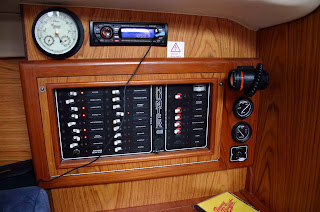One such regulation states that untreated sewage cannot be discharged into inland or coastal waters. This means the sewage collected in our "head's" holding tank can only lawfully be discharged overboard if we take Smitten further than three miles offshore on any ocean surrounding the United States. An unlikely scenario this summer.
Which is why, every couple of weeks, we find ourselves here, at "D" dock in DuSable Harbor.
 "D" dock, as well as a handy spot to pick up passengers for our standard three hour tour, is the site of one of the City of Chicago Park District's holding tank pump-out stations. This innocuous-looking white box, at the press of a button, turns into a roaring, throbbing, sucking beast that makes short order of the nasty stuff we've been flushing into our holding tank. I trust you need no further description of the nature of that stuff.
"D" dock, as well as a handy spot to pick up passengers for our standard three hour tour, is the site of one of the City of Chicago Park District's holding tank pump-out stations. This innocuous-looking white box, at the press of a button, turns into a roaring, throbbing, sucking beast that makes short order of the nasty stuff we've been flushing into our holding tank. I trust you need no further description of the nature of that stuff. It's really quite a civilized process considering what we're accomplishing. Here's Dave wrangling the undulating yellow hose that delivers us from evil:
It's really quite a civilized process considering what we're accomplishing. Here's Dave wrangling the undulating yellow hose that delivers us from evil: Reminds me of the time years ago when Dave, my sister Dort and I rented an RV to camp in Southern California's San Bernardino mountains. At the end of our week, as we tried to accomplish the same housekeeping task at an outhouse in a state park, we discovered in the middle of the procedure that the yellow hose stowed in the nether regions of the RV was afflicted with a series of pinprick holes. The resulting festive display of dancing liquid geysers was not unlike the delightful Waltzing Waters show in South Fort Myers, Florida. Minus the colored lights. And featuring a certain, um, odeur. We were still young enough to find that sort of experience wildly hilarious.
Reminds me of the time years ago when Dave, my sister Dort and I rented an RV to camp in Southern California's San Bernardino mountains. At the end of our week, as we tried to accomplish the same housekeeping task at an outhouse in a state park, we discovered in the middle of the procedure that the yellow hose stowed in the nether regions of the RV was afflicted with a series of pinprick holes. The resulting festive display of dancing liquid geysers was not unlike the delightful Waltzing Waters show in South Fort Myers, Florida. Minus the colored lights. And featuring a certain, um, odeur. We were still young enough to find that sort of experience wildly hilarious. At the pointy end of the boat is our water tank. It's only for water that is destined to become "gray" -- we'll use this for washing dishes, taking sponge baths, and accomplishing other housekeeping tasks. It is not considered safe for drinking and the City is careful to state that on D dock. Once used, it can flow directly into the local waters.
At the pointy end of the boat is our water tank. It's only for water that is destined to become "gray" -- we'll use this for washing dishes, taking sponge baths, and accomplishing other housekeeping tasks. It is not considered safe for drinking and the City is careful to state that on D dock. Once used, it can flow directly into the local waters. The twenty gallon tank is tucked in below our V berth and filled at an opening in the anchor locker. It takes a while. It looks like I'm concentrating hard, but actually I'm totally spacing out here.
The twenty gallon tank is tucked in below our V berth and filled at an opening in the anchor locker. It takes a while. It looks like I'm concentrating hard, but actually I'm totally spacing out here.This is our navigation station. It's the nerve center of the boat with the various systems' circuit breakers, the stereo, the barometer and the desk where we stow a little bit of everything, like that drawer in your kitchen.
 On the right are the tank level gauges, the top one indicates the water tank, the bottom the holding tank. It's a satisfying moment when we pull away from D dock and they look like this:
On the right are the tank level gauges, the top one indicates the water tank, the bottom the holding tank. It's a satisfying moment when we pull away from D dock and they look like this: And you thought sailing was just one lark after another, didn't you? Just all la-di-da, tacking back and forth under lapis skies at our luvly city's front door. It's a lot of that, but those universal truths have to be honored, too.
And you thought sailing was just one lark after another, didn't you? Just all la-di-da, tacking back and forth under lapis skies at our luvly city's front door. It's a lot of that, but those universal truths have to be honored, too.
No comments:
Post a Comment